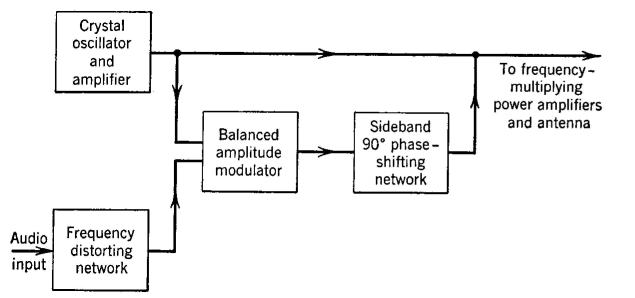| Electrical Communication is a free textbook on the basics of communication technology. See the editorial for more information.... |

|

Home  Radio Systems Radio Systems  Methods of Producing Frequency- Modulated Waves Methods of Producing Frequency- Modulated Waves |
|||||






|
|||||
Methods of Producing Frequency-Modulated WavesMany methods of frequency modulation are used in broadcast and other radio applications.
Indirect Frequency Modulation by Wave Synthesis. This method follows directly from Roder's investigation,41 It was the system used by Armstrong,42 and is used in modified form in broadcast transmitters. The block diagram of Fig, 24 shows an arrangement by which a frequency-modulated wave is synthesized, following statements given in the preceding section.
Direct Frequency Modulation Using the Reactance Tube. The reactance-tube method is shown in Fig. 25 and is the outgrowth of methods of controlling the frequency of the local oscillator in an amplitude-modulation superheterodyne receiver.44,45 It is defined2 as reactance modulation. Briefly, the alternating voltage from the oscillator existing across C-L causes a current to flow down through C1, which is of small capacitance (and high reactance), and through R1, which is of small resistance. This current and the voltage drop across R1 will lead the voltage across points 1-2 by essentially 90°. Because in the circuit used the plate current is in phase with the grid voltage, the alternating plate current of the reactance tube that flows to the right of points 1-2 will lead the voltage across points 1-2 by essentially 90°, The magnitude of this current is varied by the modulating audio-frequency signal voltage connected as indicated. This is equivalent to connecting a voice-controlled capacitor across points 1-2, and hence the incoming modulating signal causes the oscillator output to be frequency modulated. The positions of R1 and C1 may be interchanged if the proper values are selected. Also, tubes in push-pull are used.46,47 Frequency Modulation by Special Tubes. Several special tubes have been developed for producing frequency-modulated waves, one being the Phasitron.48 In this device, electrons are emitted from a central cathode and flow out in the form of an electron disk toward surrounding cylindrical anodes. Below the disk of electrons are special electric deflecting electrodes composed of wires connected successively to the phases of a three-phase radio-frequency voltage. This voltage is obtained from phase-splitting networks that are driven by a single-phase crystal-controlled oscillator. These deflecting wires will move the various parts of the electron disk up or down, depending on the polarities of the various wires. This will cause the edge of the electron disk to be "scalloped" sinusoidally and, furthermore, the scallops will move around the edge of the disk at a definite rate because the three-phase radio-frequency voltage impressed on the wire electrodes will produce a "revolving" electric field. Two cylindrical anodes are provided. The innermost has square holes in it, and the two anodes are connected to a tuned output circuit. As the electron disk rotates, electrons flow first to one anode and then to the other, causing a high-frequency current flow in the tuned output circuit. The modulation is effected by passing the modulating signal current through a coil surrounding the entire tube structure. The electron disk, with its sinusoidal scallops, is advanced in phase and retarded in phase, by the magnetic field produced by the modulating signal current in the surrounding coil, thus producing phase modulation. This current is prcdistorted so that the output wave will be frequency modulated. Frequency Modulation by Non-Linear Coils. Among the miscellaneous methods of frequency modulation is a circuit using a non-linear coil.49 This system has been used extensively in systems of communication (as distinguished from broadcast) using frequency modulation. Actually, the circuit produces phase modulation, and prcdis-tortion is necessary.
|
|||||
Home  Radio Systems Radio Systems  Methods of Producing Frequency- Modulated Waves Methods of Producing Frequency- Modulated Waves |
|||||
Last Update: 2011-05-30



